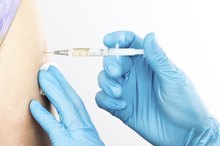What Is the Difference Between Calcitriol & Vitamin D3?
Growing awareness concerning vitamin D deficiency has resulted in more individuals taking measures to avoid it during the winter months. However, less individuals feel knowledgeable on the effects of the vitamin once inside the body, or how the various analogues within the vitamin D family interact.
Vitamin D
Vitamin D actually refers collectively to a number of compounds that share a similar structure. Some of these exist in food and others are made in the body from these compounds. The National Institutes of Health notes that vitamin D deficiency may occur when you do not spend sufficient time in bright sunlight, something individuals living in more Northern states cannot do between November and March due to the reduced intensity of solar rays at this time.
Vitamin D3
Coagulant Drugs & Vitamin K
Learn More
Along with vitamin D2, vitamin D3 occurs naturally in foods. However, the greatest effect normally comes from the manufacture of vitamin D3 in specialized cells under the skin; these localized zones produce the nutrient following exposure to sunlight of sufficient intensity. Dr. Joseph Mercola, the American physician who has wrote a number of books on alternative approaches to healthcare, recommends the use of vitamin D3 supplements as they boost the body's vitamin D status more effectively than their D2 counterparts.
Calcitriol
Calcitriol is the active form of vitamin D. It does not exist in foods, but your body can make it provided it receives an adequate supply of vitamin D2 or D3. These food-form nutrients first undergo conversion into calcidiol, the storage form of vitamin D. As and when required, the body will then alter this into calcitriol; this compound takes responsibility for the range of positive effects associated with vitamin D.
Vitamin C & Estrogen Level
Learn More
Dr. John Holick, the head of the vitamin D council, notes the importance of calcitriol's actions in a variety of conditions. He explains that obtaining sufficient amounts of D3 in the diet will ensure that all these positive effects occur. For those who suspect a vitamin D deficiency, he recommends taking 5,000 IU of vitamin D3 each day for three months before having blood tests to see if you need to alter the dosage.
Related Articles
References
Writer Bio
A London-based personal trainer, nutritional therapist and allergist, Marek Doyle runs Blueprintfitness.co.uk and counts world champion athletes and TV personalities amongst his clientele. He has contributed to various publications, including Good Life magazine, Natural News and PTontheNet.









